|




| |

15/12/2007
ANTIGUA AND CLOUDS
We arrived 2 days ago, but only now we find the time to write: they've been two frantic days!!
A brief summary: the bad weather that was annoying us since two weeks had
evolved into "sub-tropical Storm OLGA", which was creating some concerns among
the fleet but in fact we were BEHIND it so we only got some strong winds and a
bit of seas, but not much worse than in previous days.
We reduced sail a bit in order to slow down and arrive at dawn, and that's how
it went: at 8 o'clock we were entering Jolly Harbour. 2 hours spent to do
Customs, Immigration, Port Authority and then we got a place in the Marina, just
to jump off the boat and into a car to reach the other Rally people who were
having lunch at a nearby beach restaurant.

After the lengthy customs & immigration
formalities, Shaula gets a mooring at Jolly Harbour Marina.
Just the time to get some EC Dollars from the bank (ATM's do not work with most
foreign cards), some shopping in the nearby supermarket, and then the Party
hosted by the Ministry of Tourism. Next morning, still stunned by the 47
Rum-Punches of the night before, we cast off to go to English Harbour or, more
exactly, to Nelson's Dockyard, the ancient base of the English fleet in the
Carribbean now restored as a Park which is also a working marina.
The place is really stunning, the classical postcard setting, really charming.
Clouds??? Of course, clouds have not stopped and every 2-3 hours a short shower
is wetting everybody!!.
Tomorrow, dinghy trip to a nearby beach for a group Barbecue!!
16/12/2007
NELSON AND CLOUDS
I was planning to change this title theme, but here it keeps raining.....
OK, we are at Nelson's Dockyard (where in fact Nelson just spent some years when
he was a young and yet-unknown officer: he had no major role in the creation of
these premises, but he is now famous, so the rules of marketing demand his name
to be used!...).

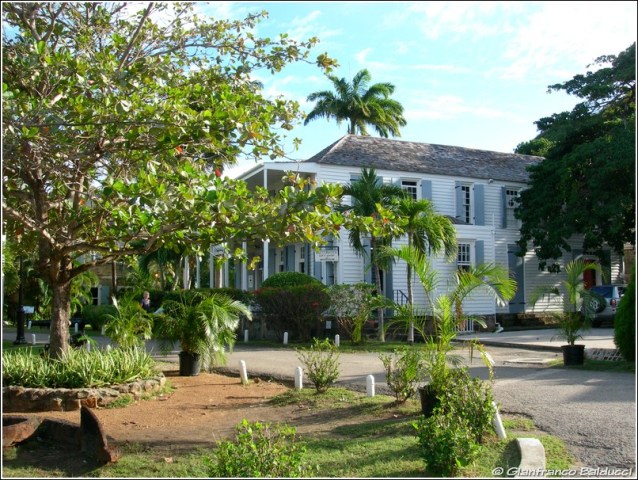
This morning we had to assemble the brand new inflatable tender, which we needed
to cross the harbour and reach a beach on the other side where the Rally people
is having a barbecue.
First thing, the inflator's pipe is not of the right size! Nearly 2000 Euros of
inflatable, and you are not even entitled to a working inflator....
A brief interval: I take a ride with another Rally member to cross the harbour
on his dinghy and reach the chandler where to buy the US-standard electric
plug: price, 540 EC$ (about 160 Euros!!!) Heck, this is extortionate!!
And the shopkeeper also asked us whether we were sure this is the right plug!! (for
that price, I would expect THEM to tell us which is the right one!!).
Ok, the tender is inflated, the brand new 6HP Mercury outboard is running, we
can go!!
The engine is running a bit roughly, but somehow we reach the beach, all 15
meters of it, where the others are already cooking their meals.
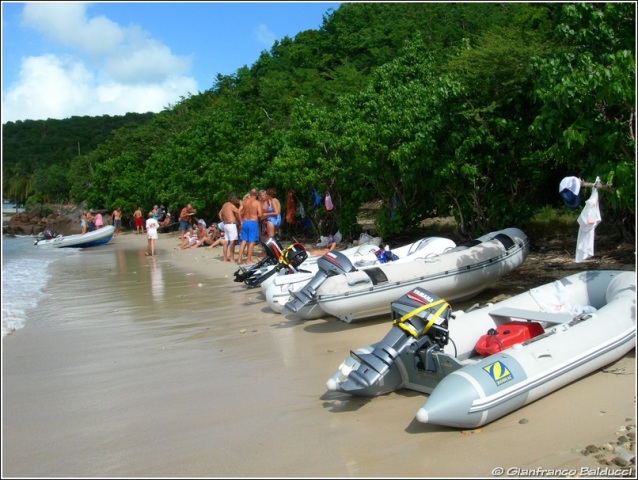
Needless to say, every now and then it rains: 2 minutes, and you are soaked!!
Back onboard, we drop on our bunks.
It's raining again. 6 times. What a bore!!
17/12/2007
STEEL BANDS AND CLOUDS
Boys, these folk can play music!!
I don't know how they can extract these sounds from steel drums (although in
reality they are now custom-made musical instruments) but they do!!
Summary: we are moored at Nelson's Dockyard, and today is Sunday, therefore there
is nobody around here, not even the port's staff: if you arrive by Sunday, bad
luck!!
In the afternoon we took a taxi up to Shirley Heights, a hill just in front of
English Harbour with a spectacular view on both English and Falmouth harbours.

Apparently, half of Antigua gathers here on Sundays: there is a steel band
playing, and stalls selling barbecues and Rum-Punches (by now, we are stone-drunk!!)
It's incredible what they manage to get out of their tin drums: this is MUSIC,
no kidding!! Although in fact listening to "Silent Night" played this way is a
little odd, they manage a full orchestration.

Funny how they play: many just stand in front of their instrument, looking
straight ahead into nothing, keeping their arms straight down inside the drum:
they just move their hands at an incredible speed!
It's 8 in the evening and we are falling asleep!! Good night everybody!!
24/12/2007
FAREWELL, GUADALOUPE!
Short stop in Pointe ą Pitre, Guadaloupe island.
For those who do not have it in mind, Guadaloupe is shaped like a butterfly,
with Pointe ą Pitre sitting just in the middle, between the two "wings" which
are as different as it goes: volcanic, mountainous and covered by rainforest the
west "wing", flat and featureless the east "wing".
The Bas-du-Fort Marina is OK, well organised and surrounded by all types of
shops, but the road to the town goes through an area which looks like a slum;
this morning we went to town on our folding bycicles and we liked it so much
that we returned by taxi, with our bikes folded in the trunk....
In the afternoon, a heavy rainstorm: it's still all wet and dripping!


The same picture, taken few minutes apart!
You can see we are in France: only in the Marina, we counted 5 or 6 OVNI's (plus
ourselves, of course!): it looks like they all come this way!
Tomorrow morning, after a quick shopping round in search of:
- "nice-looking" plastic glasses (for when we hold parties on board)
- a spare regulator for the wind generator (probably not working)
- a diving mouthpiece (I managed to lose it!)
We will leave for the "Iles des Saintes", just south of Guadaloupe and
reportedly a very nice place, where we will spend Christmas.
26/12/2007
SAINTS...
Les Saintes, to be precise! These islands have been named by Christopher Columbus
himself, no kidding!!
The place is obviously very popular and full of boats!
We are anchored in an harbour in front of the only township, Terre-de-Haut, on
the island by the same name. The village is a strange mixture of Caribbean and
Breton, and most buildings along the road turn out to be restaurants or
tourist-shops.
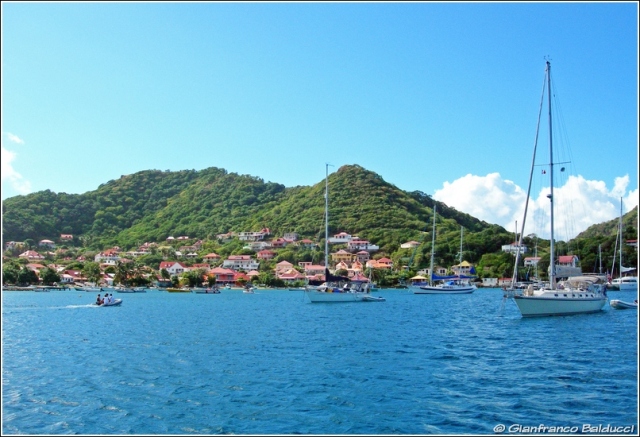
The anchorage in front of Terre-de-Haut

The main road
Yesterday we met PELLE 5, another Blue Water Rally boat (a HUGE Hallberg Rassy),
which stopped here for the Christmas day's celebrations and this morning has already left, bound for the
Grenadines.
We will stay here today, and plan to leave tomorrow to go to Dominica, the next
island to the south.
Today tourism, if we have time, and repairs: I must find out why the
wind-generator is not generating anything! (and the
spare regulator we bought in Guadaloupe did not solve the problem.
After a lengthy investigation, I found a fuse-box hidden in the boat's bowels,
were the yard had put a fuse of the wrong value!)
29/12/2007
RAINFOREST
They do not call it RAINforest for nothing!! We are in Prince Rupert Bay, a
large harbour in the north of Dominica, near Portsmouth that is the
second-largest town of the island. No big deal though, the island is very poor
and until few years ago its bad reputation was keeping tourists well at large;
the town is just a village of wooden houses (or shacks, more appropriately);
along the beach, the rusty hulks of three or four ships, washed ashore by a
hurricane 12 years ago and still there!!

Dominican boat-boys have a bad reputation, but
things have changed a lot and they are now providing a good service

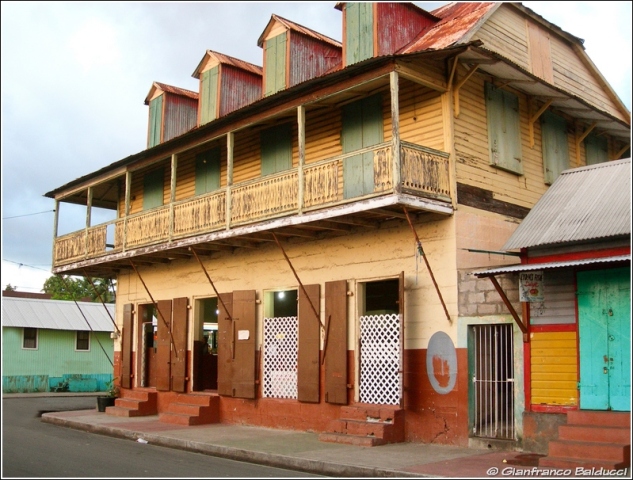
The positive side of this situation is that the island is still covered by very
dense and quite scenic forests, worth a visit; this morning we went with a local
boat in the so-called "indian river": some takes of the movie "Pirates of the
Caribbean" have been shot here, the place is in fact quite scenic, although we
did not see any of the promised wildlife, neither the iguanas nor the Boa snakes
or the "mountain chicken" (which are actually a kind of frog). At least we saw
some green-backed herons, a few crabs and a lot of gorgeous plants and flowers,
not to mention the intricate tree roots.


Only, minor inconvenience: RAIN!!! Frequent and wet!!! We returned to the boat
soaking wet, but besides that, the whole trip would have been more spectacular
with a little bit of sun!
If we do not leave, tomorrow we may give it another try, this time by bus (the
locals are quite poor, but they are beginning to get organised!...)
By the way, this island is the home of the only remaining settlement of the
Caribe indians, those who created a lot of trouble for Columbus and many others
following him; there are only 3500 left, and only in the last century they have
buried their gripes with white colonizers and have stopped using them for food...
30/12/2007
MORE RAINFOREST...
Change of plans! Instead of leaving this morning, we joined two other Rally
crews in a trip around the island by mini-bus.
All the island is covered by rainforest, only occasionally replaced by palms (a
funny kind of palm, with a very tall, bare trunk and few leaves at the top), and
every now and then we ride along a banana plantation (we were told there are 7
different variants of banana, 5 of which are eaten as fruits, while the other 2
are cooked like a vegetable): did you know that a banana tree grows fruit only
once, then it must be cut and within 8-9 months a new plant will grow and make
new fruits?
The island is quite mountainous, with steep hills dropping down to the
occasional beach: it must have been hard life for the first colonizers, with a
thick forest hiding ferocious indians just few meters from their landing
spot!...
Nearly needless to say, the indian colony is in one of the roughest parts of the
island, although you can see incongruous signs of civilization, such as the hut
where DVD's are rented, or the one selling mobile-phone airtime top-ups
(...mountain road, not a village within several kilometers, and you meet two or
three well-dressed people walking while talking on a mobile phone: where are
they going? To church, maybe? In fact churches, of all possible denominations,
are quite frequent).
Strange houses, most of them very simple, wooden ones (when they are not
outright shacks), although sometimes there's a new and expensive car parked
nearby, but occasionally luxurious, colonial-style mansions can be seen (apparently
belonging to the land-owners).


Sadly, abandoned rusty cars are frequently seen along the roads: it looks like
nobody knows how to dispose of them, so they are just left there.
The trip ends at a National Park, with a short walk in the rain forest (complete
with vines, and garish-coloured tree roots, and birds, like the "trembler",
getting its name from its rapidly-vibrating tail, and the tiny and hard-to-see
hummingbirds).
At the end of the trail, a waterfall dropping in a small lake: we ignore it,
unlike Baby who decides to make a plunge and regrets her decision as soon as she
hits the ice-cold water!


Back to the boat and, guess what, it starts raining!
This evening we plan to set sail towards Martinique, in order to get there by
early morning.
31/12/2007
MARTINIQUE
The town of Fort-de-France (MARTINIQUE) was desert when we got here yesterday by
early afternoon: it was Sunday, and they seem to take it seriously, all shops
were closed (except a MAC DONALD's and a KFC....) and there was nobody in the
streets, except the occasional policeman.
Creole atmosphere, run-down houses even in the city-centre, a "cathedral" that
seems coming from Louisiana, but also a few luxury shops (Galeries Lafayette??
In Martinique???) which probably cater to passing-by tourists (as there doesn't
seem to be any who stay here!).





The wall decoration outside a local "Night Club"
In the evening, life bursts out big-time: music in the main square, fireworks
being shot from the ancient fort's walls, just in front of our anchorage. A lot
of boats of all sizes have joined us to watch the show, the noise is deafening.
Let's hope there will be some events this night as well (it's new-year's eve):
50 meters from us, a cruise ship has moored, discharging a lot of people; in a
while, we will do the same.
HAPPY NEW YEAR!!
01/01/2008
WET NEW-YEAR'S EVE....
2008 begins, and it begins with a series of downpours, damn!!!
Yesterday night, our "dinner" was planned around a barbecue in the cockpit, but
this turned out to be impractical due to the rain, so we had to cook and eat all
the stuff down in the comfort of the cabin.
The midnight toast fared slightly better, thanks to a temporary breack in the
rain, so we had an opportunity to:
- drop candle-wax everywhere on the cockpit floor
- stain with blue, green and violet stripes both the cockpit and the dinghy (thanks
to non-water-resistant confetti!!)
- make a toast (with Veuve Clicquot, no less!)!! HAPPY NEW YEAR!!!
- have a slice of traditional "pandoro" cake that we bought back in Lanzarote
- shoot a movie that turned out to be black throughout!
...By the way, while Sunday the town was empty, on Monday everybody was out and
all shops were open: if I had to define the town with one word, that would be
ELEGANCE: elegant shops (despite the building being maybe a little run-down),
selling good-tasted stuff, and the people you see around are good-looking and
well-dressed. Nearly all of them are black, of course: it's clear that blacks
here are at all levels of the social ladder.
And they all speak FRENCH, also between themselves, unlike in the
british-influenced islands, where they talk in some incomprehensible dialect and
their english is heavily accented.
A little curiosity which puzzled Baby: we were at a supermarket, the cue at the
cash was very long, and it looks like trying to jump the cue is the local sport.
Most people gets sent back by those in the cue, but there seem to be odd
exceptions, expecially for old ladies...
This morning we left Fort-de-France heading south: now we are anchored for the
evening in Rodney Bay, Saint Lucia; before dawn we will leave towards Saint
Vincent and the Grenadines.
05/01/2008
PIRATES OF THE CARIBBEAN!
This movie is becoming an obsession! And the locals had to adapt to this.
In Dominica, they shot some takes along the Indian River (remember that
nightmarish pond at the end of PotC 2?? IT'S REAL!!)
Also in Dominica, in the north, they shot some battle scenes (the duel on the
weel?!!)
In Saint Vincent, in a bay by the improbable name of Wallilabou Bay, there was
the main set with the village and the pontoons, although by means of
wisely-chosen camera positioning the village was made to look much bigger than
it actually is, and even the bay seems larger. In the movie, you don't realise
there are two pontoons, it seems like one only (remember Johnny Depp flying from
a ship hanging from a loading crane? It's there!!).

The anchorage in Wallilabou Harbour, with the
remainders of "Pirates of the Caribbean" movie set
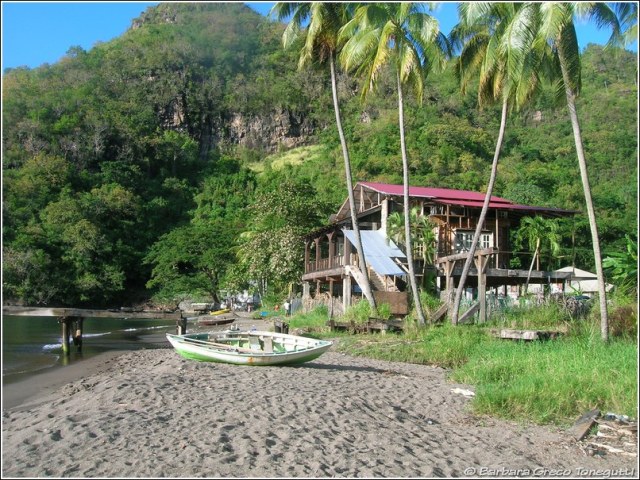
Only problem, it was not built to last, and everything is falling apart and will
be gone in few more years, depriving the enterprising locals of their tourist
attraction (although the bay would be nice on its own).
OK then, we anchored with a line led ashore from our stern (led by one of the
many guys that jump at you offering all kinds of services and products, from
taking your lines or ferrying you ashore - OK, it's an useful service - to
offering improbable-looking fruit, bread, more fruit, fish, more fruit, and so
on).

The available transport ashore range from waterlogged wooden rowboats to a
fiberglass hull with the bow missing but equipped with an outboard (the
harbour's rich man, apparently), to surf boards without the sail, down to a
deflated RIB where an impossibly ugly guy stands precariously, rowing with a
section of tree bark and going around the boats offering fruit that nobody buys.
We ended up dining ashore and being ferried back onboard by the guy with the
boat with a missing bow and an outboard; he speaks a few words of italian,
apparently he works on some italian boats in the Capital city's marina during
the low season.
Next day, 20 miles south to Bequia island, which is a sort of entry gate to the
Grenadines, a group of little islands and coral reefs stretching south of here.

The atmosphere is quite different from the places seen until now: tourism is
their only income and the place is a funny mixture between good quality hotels
and restaurants and a shipping dock that seems to come from a 1930's movie or
the fruit and veg market where incredibly ugly, rasta-styled guys turn out to be
very friendly and kind, if a bit too insistent.
Prices are influenced as well by the general "I'm on vacation, what the hell!"
attitude; Baby was afraid of being robbed by a gang of boat-thieves, while here
thievery is legalised!
Tomorrow, with our wallets duly emptied, we will head towards the Tobago Cays,
another of the top objectives of this voyage; several Rally boats are already
there or have visited and have left, heading west. Like often, we are among the
last ones in the group.
06/01/2008
A TURTLE WAVED ME "HELLO"!
OK, the turtle was not caring of me at all, still I met nose-to-nose with one,
an Hawksbill Turtle, to be precise! She seemed to know to be completely safe
from any harm, we are in the Tobago Cays National Park, and the only ones
running any risk are the tourists! (risk of being run-down by a speeding boat,
risk of being robbed by a bread seller - 15 EC$ for ONE bread loaf!??).

We reached the Cays only this morning, duly zig-zagging between reefs and
anchored yachts, just in time to wave hello to some Rally yachts which were just
about to leave. In fact we had planned to get here yesterday, but we were
delayed by a failure of our anchor windlass, that we discovered just by chance
the other night in Bequia.
So yesterday morning we had to tackle the windlass problem before heading
towards the Cays, where a speedy anchor handling could be critical. We found out
that the main power fuse has blown, and after some head-scratching we trace the
problem to the remote control, where the "UP" and "DOWN" buttons have shorted
together. After having fixed the problem, it was too late to reach the Cays
before sunset, and we would not tackle the reefs in limited visibility, would
you?
Solution, we stopped at Saltwhistle bay, on Mayreau island, a picture-postcard
setting, with palms on the beach and a restaurant hidden between the palms:
could we not go and have dinner there? No, of course we had to go, although the
outcome was lukewarm: passable food, but rude waiters and prices worthy of New
York's 5th Ave.

The anchorage in Saltwhistle Bay, Mayreau island
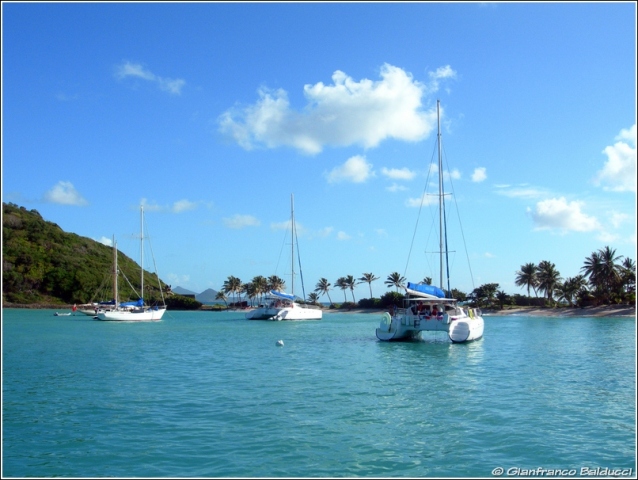
Picture-postcard scenery!
Next morning, after having been robbed by the bread-seller-turned-pirate, we
tackled the one-hour transfer to the Cays, so here we are!

The anchorage behind Horse-shoe Reef, seen from Baradal island

Taking a plunge looking for turtles!
Wonderful setting, but tomorrow we will have to set sail for the Dutch Antilles,
Bonaire to be exact; we will stay offshore (very MUCH offshore!) of Tortuga
which to the present day is not an entirely safe place, and we will reach our
destination in about 4 days.
08/01/2008
SAILOR'S FOOT
Don't know if this expression works also in english, anyway in italian "having a
sailor's foot" means to be accustomed to the boat's motion, a capability we lost
quickly during one month of coastal cruising with a gentle wind on the beam. Now
we will have to endure some days with following wind and seas (and the
associated rolling...) and it looks like it will be tough!
Very un-characteristically, the wind is light, apparently the trade winds will
be on vacation for a while. Let's hope it will be the same during the following
leg from Bonaire to Panama (by way of the San Blas islands) which is frequently
very tough, with strong winds and heavy seas.
16/01/2008
DUTCH ANTILLES
Bonaire, then: we got here in less than 4 days, one less than planned thanks to
a very strong favourable current of up to 2 knots (not likely to happen again
any time soon!).
We even found a mooring in the tiny Marina (about 60 places in total) which has
been swamped by the Rally boats, now mostly gone. Only drawback, it's far from
Kralendijk city centre, but that is easily solved by our folding bikes first,
and then by a decrepit rental 4WD car.

The tiny Harbour Village Marina, north of Kralendijk
Completely different from what we saw until now, the island is mostly flat and
bare, except for a small mount at the northern end, which is part of the
"Washington Stinapa" National Park. A tour of the park is not to be missed, and
it takes several hours along dirt tracks that put to a test the springs of our
4wd and that require frequent stops to watch something.
Cactus: FORESTS of Cactii, like in a cartoon, tall and two- or three-armed ones,
not just one or two, but a large expanse covered with them.

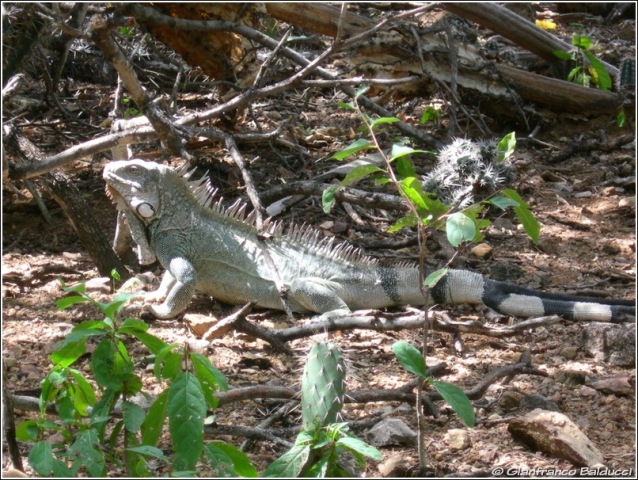
Iguanas: the first one was carelessly crossing our path yesterday, others we saw
in the park, normally because they moved while we were watching, otherwise they
hide very well between the cactus and other bushes.
Pink Flamingos: this is the home of pink flamingos, they come every year to
build their nests and lay their eggs, so every pond or swamp is full of them.
Tough to take a photo, they do not let you get any close and keep their heads in
the water most of the time. Only Baby got a good picture of one flamingo,
together with a huge pelican.


Bonaire is a diver's paradise: everywhere around the shore there are buoys to
allow divers to moor and have a plunge, with or without tanks.
We did not carry tanks, and just got into the water from one of the Park's
beaches: we quite literally were swimming among fishes, big, unafraid and
curious, we literally had to shoo them away!! An american fellow who was diving
there told us that 10 meter deep he saw plenty of lobsters (which are obviously
protected, like everything else: when arriving in Bonaire, you have to give any
fishing gear to the police!)
Baby resents not being allowed to collect shells, but she will have to adapt.
Monday 14th, we leave for the 750 miles to the San Blas islands, Panama. This
stretch of sea is infamous for its bad weather, and the forecasts are not very
good, let's hope for the best!
CAPSIZED!!
January 18, 2008, 14:00 hrs, about 150 miles NNE of Panama: I've just stepped
down below decks and I'm standing beside the chart table, taking the oilskin
off, when the boat starts a very fast roll to starboard: I have the time to think "she's not
stopping!!" and I find myself tumbling over and being bombarded by various
objects which are flying around.
The boat finally stops rolling, leaning on its side, and while I try to regain
my balance I stare at the flow of water cascading inside from a small gap left
open in the companionway: "if she does not right herself quickly, we are going
to sink", I think while several seconds pass by and then, suddenly, the boat
rights up and I fly around again!
Alarms are beeping around me, but my first priority is to go out and check what
happened to Barbara, who might be in the water; I have to crawl through the
remnants of our shredded sprayhood and then I find the cockpit in a mess. A
quick glance towards the mast: it's still there! But first things first, Barbara
is on the outside of the boat, hanging like a koala from the lifelines! The
dodger which was tied to the lifelines where Barbara is now hanging has been
shredded away, so I can manage to help her while she crawls under the lifelines
back on deck.

The sprayhood has been completely shredded
The windvane's wooden vane is no longer there, so one of us takes the helm and
then we start checking around for damages: the mast is still in place, but the
starboard crosstrees are bent and the shrouds are slack. Our horse-shoe lifebuoy
is hanging from the crosstrees, still attached to its automatic danbuoy, which
has inflated.


Our inflatable dan-buoy is hanging from the crosstrees, and the cockpit floor
has been lost to the sea
Everything which was on the starboard deck has been swept away, the stanchions
are bent and the lifelines slack, the teak cockpit floor has disappeared
together with other stuff, and the wind pilot is twisted, besides having lost
its vane.
We roll a bit further in the headsail and steer with the wind on the port quarter
in order to leave the slack shrouds on the downwind side, and recover all the
lines which have been swept overboard and might get trapped in the rudder or the
propeller.
All electronics are off, and the engine (after a quick check to make sure it's
not flooded) does not start!
Below decks, all lockers on the starboard side are flooded, the nautical charts
are soaked, computers and other electronics are awash, the main switchboard has
been flooded as well and there are beverage cans and other stuff stockpiled
everywhere on the starboard side of the boat.
The main GPS receiver is not working, and the spare one is full of water, the
mast-head VHF aerial is bent but strangely both the SSB and the satphone are OK,
although we will have to use them very sparingly as the only surviving sources
of electricity are the wind generator and the solar panels and the first
priority will be to feed the nav-lights.
We take the handheld GPS out of the emergency grab-bag, just to discover that it
eats the batteries very quickly and therefore we will have to switch it on only
from time to time.
Next job, emptying the bilges (one of the electric pumps does not prime, so we
have to use the bucket!) and then we start checking the mess, putting stuff back
to where it belonged and trying to salvage the soaked items. Luckily we manage
to put back in operation the windvane, despite it's bent, so at least we do not
have to hand-steer and the wind blows from the NE, allowing us to sail on port
tack towards Panama. We are very worried though because a small wind shift to
the North would send us towards the dangerous San Blas islands, with no engine
and limited sailing capability.
During the 18:00 hrs radio check we manage to talk to the other Rally boats (most
of which are already at anchor in the San Blas islands) and we inform them of
our intention to go straight to Panama. We will later learn that they informed
the Panamian authorities about our situation, and they in turn informed the
Italian Coast Guard who started calling us at regular intervals on the satphone:
there was not much they could do, but it was comforting to know that we were
being monitored.
24 hours after the accident, the situation on board was a bit more under control
and we were in radio contact with an italian freighter which had altered course
to pass near us, upon request from the Rome MRCC: again, they cannot do much, as
we are not in need to abandon-ship, but it's anyway a much needed
morale-booster: we are very tired and stressed, and Panama is still another day
away!
Just minutes before the freighter "Cittą di Roma" overtook us while blowing
their whistle, our engine decided to start!! Just on time, as the wind was
fading away and we were forced to hand-steer under engine all the way to Panama,
that we reached after another 24 hours; totally exhausted, but we had done it!

Damaged Shaula limps into Shelter Bay Marina (Panama)
(Go to
THIS PAGE to read our analysis of the
accident)
(and go to
THIS PAGE to watch the movie)
CONTINUE
READING...
|